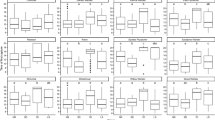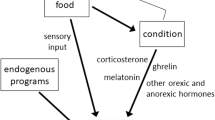Summary
Local concentrations of migrating, fat-depleted birds with similar diets can lead to increased competition for food at a time when energy demand is high. Results of a predator-exclosure experiment indicate that intercontinental passerine migrants depress food abundance during stopover following migration across the Gulf of Mexico. Moreover, migrants that stop when a high number of potential competitors are present replenish energy reserves more slowly than migrants that stop under low density conditions. Competition increase the rate of food depletion and may decrease the probability that a migrant will meet its energetic requirements and complete a successful migration.
Similar content being viewed by others
References
Alerstam T (1981) The course and timing of bird migration. In: Aidley DJ (ed) Animal migration. Cambridge University Press, Cambridge, pp 9–54
Bairlein F (1985) Body weights and fat deposition of Palaearctic passerine migrants in the central Sahara. Oecologia 66:141–146
Berthold P (1975) Migration: control and metabolic physiology. In: Farner DS, King JR (eds) Avian biology, vol 5. Academic Press, New York, pp 77–128
Bibby CF, Green RE (1980) Foraging behavior of migrant pied flycatcher, Ficedula hypoleuca, on temporary territories. J Anim Ecol 49:507–521
Biebach H, Friedrich W, Heine G (1986) Interaction of body mass, fat, foraging and stopover period in trans-Sahara migrating passerine birds. Oecologia 69:370–379
Blem CR (1980) The energetics of migration. In: Gauthreaux SA (ed) Animal migration, orientation, and navigation. Academic Press, New York, pp 175–224
Carpenter FL, Paton DC, Hixon MA (1983) Weight gain and adjustments of feeding territory size in migrant hummingbirds. Proc Natl Acad Sci USA 80:7259–7263
Cherry JD (1982) Fat deposition and the length of stopover of migrant white-crowned sparrows. Auk 99:725–732
Child GI (1969) A study of nonfat weights in migrating Swainson's thrushes (Hylocichla ustulata). Auk 86:327–338
Collins CT, Bradley RA (1971) Analysis of body weights of spring migrants in southern California: part II. West Bird Bander 46:48–51
Connell C, Odum E, Kale H (1960) Fat-free weights of birds. Auk 77:109
Dolnik VR, Blyumental TI (1967) Autumnal premigratory and migratory periods in the Chaffinch (Fringilla coelebs coelebs) and some other temperate zone birds. Condor 69:435–468
Francis CM, Cooke F (1986) Differential timing of spring migration in wood warblers (Parulinae). Auk 103:548–556
Gauthreaux SA (1971) A radar and direct visual study of passerine spring migration in southern Louisiana. Auk 88:343–365
Gauthreaux SA (1972) Behavioral responses of migrating birds to daylight and darkness: a radar and direct visual study. Wilson Bull 84:136–148
Goss-Custard JD (1980) Competition for food and interference among waders. Ardea 68:31–52
Graber JW, Graber RR (1983) Feeding rates of warblers in spring. Condor 85:139–150
Gradwohl J, Greenberg R (1982) The effect of a single species of avian predator on the arthropods of aerial leaf litter. Ecology 63:581–583
Helms CW, Drury WH (1960) Winter and migratory weight and fat: field studies on some North American buntings. Bird-Banding 31:1–40
Holmes RT, Schultz JC (1988) Food availability for forest birds: effects of prey distribution and abundance on bird foraging. Can J Zool 66: 720–728
Holmes RT, Sherry TW (1988) Assessing population trends of New Hampshire forest birds: local vs regional patterns. Auk 105:756–768
Holmes RT, Schultz JC, Nothnagle P (1979) Bird predation on forest insects: an exclosure experiment. Science 206:462–463
Hutto RL (1985) Seasonal changes in the habitat distribution of transient insectivorous birds in southeastern Arizona: competition mediated? Auk 102:120–132
Kale HW (1967) Aggressive behavior by a migrating Cape May warbler. Auk 84:120–121
Keast A, Morton ES (eds) (1980) Migrant birds in the neotropics. Smithsonian Institute Press, Washington D.C.
Kodric-Brown A, Brown JH (1978) Influence of economics, interspecific competition, and sexual dimorphism on territoriality of migrant rufous hummingbirds. Ecology 59:285–296
Kuenzi A (1989) Stopover biology of nearctic-neotropical passerine migrants on East Ship Island. MS thesis. University of Southern Mississippi, Hattiesburg, MS
Laursen K (1978) Interspecific relationships between some insectivorous passerine species, illustrated by their diet during spring migration. Ornis Scand 9:178–192
Lavee D, Safriel UN (1989) The dilemma of cross-desert migrants — stopover or skip a small oasis? J Arid Environ 17:69–81
Lima SL (1985) Maximizing feeding efficiency and minimizing time exposed to predators: a trade-off in the black-capped chickadee. Oecologia 66:60–67
Lindstrom A (1989) Finch flock size and risk of hawk predation at a migratory stopover site. Auk 106:225–232
Lindstrom A, Alerstam T (1986) The adaptive significance of reoriented migration of chaffinches Fringilla coelebs and bramblings F. montifringilla during autumn in southern Sweden. Behav Ecol Sociobiol 19:417–424
Loria DE, Moore FR (1990) Energy demands of migration on red-eyed vireos, Vireo olivaceus. Behav Ecol 1:24–35
Lowery GH (1946) Evidence of trans-Gulf migration. Auk 63:175–211
Marsh RL (1984) Adaptations of the gray catbird Dumetella carolinensis to long distance migration: flight muscle hypertrophy associated with elevated body mass. Physiol Zool 57:105–117
Martin TE (1985) Selection of second-growth woodlands by frugivorous migrating birds in Panama: an effect of fruit size and plant density. J Tropical Ecol 1:157–170
Martin TE (1986) Competition in breeding birds — On the importance of considering processes at the level of the individual. In: Johnston RF (ed) Current ornithology, vol 4. Plenum Press, New York, pp 181–210
Martin TE, Karr JR (1986) Patch utilization by migrating birds: resource oriented? Ornis Scand 17:165–174
Martin TE, Karr JR (1990) Behavioral plasticity of foraging aneuvers of migratory warblers: multiple selection periods for niches? Stud Avian Biol 13:353–359
Mehlum F (1983) Resting time in migrating Robins (Erithacus rubecula) at Store Faerder, Outer Oslofjord, Norway. Fauna norv Ser C, Cinclus 6:62–72
Metcalfe NB, Furness RW (1984) Changing priorities: the effect of pre-migratory fattening on the trade-off between foraging and vigilance. Behav Ecol Sociobiol 15:203–206
Moore FR, Kerlinger P (1987) Stopover and fat deposition by North American wood-warblers (Parulinae) following spring migration over the Gulf of Mexico. Oecologia 74:47–54
Moore FR, Kerlinger P, Simons TR (1990) Stopover on a Gulf coast barrier island by spring trans-Gulf migrants. Wilson Bull 102:487–500
Rappole JH, Warner DW (1976) Relationships between behavior, physiology and weather in avian transients at a migration stopover site. Oecologia 26:193–212
Rappole JH, Morton ES, Lovejoy TE, Rues JL (1983) Nearctic avian migrants in the neotropics. USDI/FWS. US Printing Office
Robbins CS, Sauer JR, Greenberg RS, Droege S (1989) Population declines in North American birds that migrate to the neotropics. Proc Natl Acad Sci USA 86:7658–7662
Rogers DT, Odum EP (1964) Effect of age, sex, and level of fat deposition on major body components in some wood warblers. Auk 81:505–513
Safriel UN, Lavee D (1988) Weight changes of cross-desert migrants at an oasis — do energetic considerations alone determine the length of stopover? Oecologia 76:611–619
Schneider DC (1978) Equalisation of prey numbers by migratory shorebirds. Nature (London) 271:353–354
Schneider DC, Harrington BA (1981) Timing of shorebird migration in relation to prey depletion. Auk 98:801–811
Sealy SG (1988) Aggressiveness in migrating Cape May Warblers: Defense of an aquatic food source. Condor 90:271–274
Sealy SG (1989) Defense of nectar resources by migrating Cape May Warblers. J Field Ornithol 60:89–93
Sokal RR, Rohlf FJ (1981) Biometry, 2nd edn. Freeman, New York
Stephens DW, Krebs JR (1986) Foraging theory. Princeton University Press, Princeton
Sutherland GD, Gass CL, Thompson PA, Lertzman KP (1982) Feeding territoriality in migrant rufous hummingbirds: defense of yellow-bellied sapsucker (Sphyrapicus varius) feeding sites. Can J Zool 60:2046–2050
Torgersen TR, Campbell RW (1982) Some effects of avian predators on the Western spruce budworm in North Central Washington. Environ Entomol 11:429–431
Viega JP (1986) Settlement and fat accumulation by migrant pied flycatchers in Spain. Ringing Migration 7:85–98
Wiens JA (1989) The ecology of bird communities, vol 2. Cambridge University Press, Cambridge
Wilcove DS (1988) Changes in the avifauna of the Great Smoky Mountains: 1947–1983. Wilson Bull 100:256–271
Wilcove DS, Terborgh JW (1984) Patterns of population decline in birds. Am Birds 38:10–13
Author information
Authors and Affiliations
Rights and permissions
About this article
Cite this article
Moore, F.R., Yong, W. Evidence of food-based competition among passerine migrants during stopover. Behav Ecol Sociobiol 28, 85–90 (1991). https://doi.org/10.1007/BF00180984
Received:
Accepted:
Issue Date:
DOI: https://doi.org/10.1007/BF00180984




